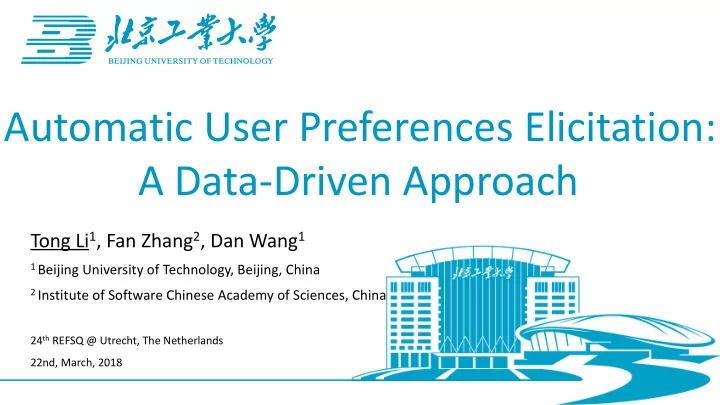

Automatic User Preferences Elicitation: A Data-Driven Approach Tong Li 1 , Fan Zhang 2 , Dan Wang 1 1 Beijing University of Technology, Beijing, China 2 Institute of Software Chinese Academy of Sciences, China 24 th REFSQ @ Utrecht, The Netherlands 22nd, March, 2018
Outline • Background and Motivation • Related Work • Proposal • Evaluation Plan • Conclusion and Future Work 2
Background and Motivation Develop a particular type of software application More than 2 Survey existing What features have million applications! been developed apps for this type of applications? (Start-up) What features are company most liked/disliked Look into Numerous by users application reviews reviews! 3
Related Work • Research on mining user reviews [Carreo2013,Guzman2014] • Mining features from user reviews • Sentiment-based preference analysis • Research on mining application descriptions[Hariri2013] • Clustering-based feature extraction • Association rule-based feature recommendation 4
������������ ��������������� ������������ ������������� ����������������� ��������������������� ���������������������� ������������������ ���������������������� Proposal Features Total Positive Negative comments Feature 1 2000 1500 500 Feature 2 100 100 0 Feature 3 500 130 370 ... ... ... ... User reviews 5
Feature Identification • A Clustering-Based Method • Generate clusters (categories): doc2vec + density-peak • A collocation finding algorithm for identifying features • Topic Modeling-Based Method 6
Feature Identification • A Clustering-Based Method • Generate clusters (categories): doc2vec + density-peak • A collocation finding algorithm for identifying features • Topic Modeling-Based Method 7
Associate features with User Reviews • word2vec for producing word embedding • Train a neural network model • quantify and categorize semantic similarities between words 8
Sentiment Analysis • Train a sentiment classifier based on • Lexical evidence • Syntactic structure • Semantic dependency 9
Evaluation Plan • RQ1 . To what extent can the topic modelling-based method and the clustering-based method respectively extract features of a category of software applications from the unstructured descriptions? • RQ2 . To what extent can the word2vec method associate user reviews with previously identified features? • RQ3 . To what extent can our proposal accurately classify sentiments of user reviews? • RQ4 . Whether software companies can benefit from our approach and would like to adopt it? 10
Evaluation Plan • Data collection • 5,000+ applications from app store • 1,000,000+ user reviews Review Association • Create a 10,000 • Randomly pick up reviews training three categories • Randomly choose dataset • Manually identify 1000 reviews features as • Manually associate grounded truth them with features Feature Sentiment Identification Analysis 11
Conclusions and Future work • A research preview about a data driven user preference elicitation approach • Methods for filtering useless information from application descriptions • Syntactic templates for feature extraction • Effective visualization algorithms 12
THANK YOU! Contact: litong@bjut.edu.cn
Recommend
More recommend